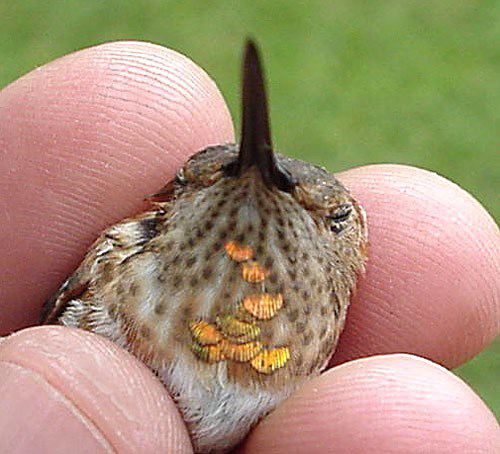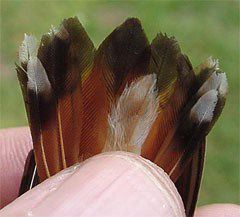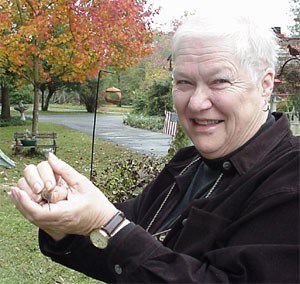 HOME: www.hiltonpond.org |
|||
|
RUFOUS HUMMINGBIRD |

All text & photos © Hilton Pond Center After our successful morning banding of a Rufous Hummingbird at Tamassee SC on 10 November 2002, we headed south toward Pendleton to investigate a new report of one and possibly two hummers visiting a feeder at the home of Nell Reeves. Pendleton was a familiar destination for us because we had been there on 24 November 2000 to band a young female Rufous. In Anderson County and not far from Clemson, Pendleton seems to be a hotbed of winter hummingbird activity, so we were confident there would indeed be at least one hummer at Nell's house.  When we arrived in Pendleton, Nell had gone to church but left word for us to do whatever we needed to capture and band any hummers we might see. Nell's backyard was nicely landscaped, including a freshly filled hummingbird feeder, a Cypress Vine, and a still-blooming purple Butterfly-bush that likely attracted the attention of hummingbirds in the neighborhood. In our usual procudure, we placed Nell's feeder inside our portable hummingbird trap, hung the device, and retired to a screened-in back porch and comfotable rocking chair to await the arrival of our quarry.  At about 10:30 a.m., a hummingbird flew to the garden and went straight to the spot where the feeder had been. The bird investigated all sides of the trap EXCEPT the one with the sliding door, perched on top for a minute, and then checked out the apparatus one more time. We were surprised by this bird's appearance since it showed none of the rusty colors of a Rufous Hummingbird--the most common of the western vagarant hummers that show up in the eastern U.S. This bird looked and acted for all the world like a Ruby-throated Hummingbird--a species much less likely than a Rufous in upcountry South Carolina in November. Ruby-throats rarely overwinter in the Carolinas, but these birds tend toward the coast where weather is more moderate than in foothills of the Blue Ridge. Unfortunately, since this bird never entered our trap, we had only our naked eyes to rely upon, but feel confident in reporting it as a Ruby-throat.  After that initial rush of activity, we leaned back in the old rocking chair and waited for something else to happen. Eventually, some of Nell's kin--including daughter Jean Ostrom who lives next door--joined us on the porch and made the waiting more tolerable. We chatted about teaching and natural history but stopped the conversation abruptly at about 11:15 a.m. when a hummingbird buzzed in. This newcomer was different from the earlier hummer and sported a great deal of rusty coloration. It was very active, darting back and forth around the trap and vocalizing (i.e., "cussing") in the style of an agitated Rufous Hummingbird male. Unlike the apparent Ruby-throat, the new bird entered the trap fairly quickly. When it did, we pushed the trigger release and soon had the hummer in hand.
Vital Statistics for Rufous Hummingbird #Y14816
Age/Sex--Hatch-year male In the end, we concluded that the Pendleton hummer was a hatch-year male Rufous Hummingbird, primarily because measurements were at the upper end of the scale for an Allen's. Since Nell hadn't returned from church when we finished with banding, the honor of releasing the young male Rufous fell to Jean--even though she was certain that Mama Nell would be more than a little jealous. To avoid any family spats, we promised to return to Pendleton as soon as possible to involve Nell Reeves in determining whether her other bird really is a lingering Ruby-throated Hummingbird.
If you're interested in sharing your hummingbird observations and learning from other enthusiasts, you may wish to subscribe to Hummingbird Hobnob, our Yahoo!-based discussion group. Also be sure to visit our award-winning Web site for Operation RubyThroat: The Hummingbird Project; on it you'll find almost anything you want to know about hummingbirds, including more information about Hummingbird Banding.
For much more information about hummingbirds, visit Operation RubyThroat: The Hummingbird Project  |
 Our new capture had extensive rust at the base of its tail, ten metallic red-orange throat feathers, and hints of rufous elsewhere on its body, so we were certain it was a young male. To verify the species identification--and especially to be sure it wasn't an Allen's Hummingbird that is similar in appearance to the Rufous--we took our standard set of measurements. The wing chord, tail length, culmen length, and other measures weren't very conclusive, since most fell within or very close to the range for both Rufous and Allen's. Even the 3mm width of the tail feather #5--which is relatively narrow in Allen's Hummingbirds--meant the bird could have been either species. This in itself was exciting, since there has never been a verified Carolinas report of an Allen's Hummingbird, a relatively sedentary species that breeds along a narrow strip of Oregon and California coastline and overwinters there or in southcentral Mexico.
Our new capture had extensive rust at the base of its tail, ten metallic red-orange throat feathers, and hints of rufous elsewhere on its body, so we were certain it was a young male. To verify the species identification--and especially to be sure it wasn't an Allen's Hummingbird that is similar in appearance to the Rufous--we took our standard set of measurements. The wing chord, tail length, culmen length, and other measures weren't very conclusive, since most fell within or very close to the range for both Rufous and Allen's. Even the 3mm width of the tail feather #5--which is relatively narrow in Allen's Hummingbirds--meant the bird could have been either species. This in itself was exciting, since there has never been a verified Carolinas report of an Allen's Hummingbird, a relatively sedentary species that breeds along a narrow strip of Oregon and California coastline and overwinters there or in southcentral Mexico. Besides, the bird already had several of the rusty back feathers characteristic of the adult male Rufous. (The adult male Allen's has a mostly green back.) Regardless, this bird reminded us that identifying winter vagrant hummingbirds isn't always easy.
Besides, the bird already had several of the rusty back feathers characteristic of the adult male Rufous. (The adult male Allen's has a mostly green back.) Regardless, this bird reminded us that identifying winter vagrant hummingbirds isn't always easy.
 Students at GLOBE-certified schools may submit winter hummingbird observations as part of Operation RubyThroat and GLOBE. Students can also correlate hummingbird observations with data on abiotic factors, including atmosphere, climate, hydrology, soils, land cover, and phenology. See the
Students at GLOBE-certified schools may submit winter hummingbird observations as part of Operation RubyThroat and GLOBE. Students can also correlate hummingbird observations with data on abiotic factors, including atmosphere, climate, hydrology, soils, land cover, and phenology. See the 


